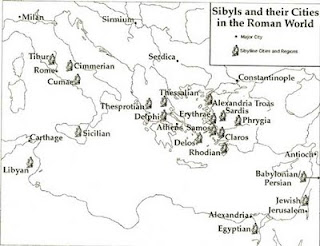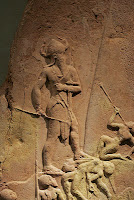Where there are temples to Apollo there you will also find the Queen of the Underworld.
In Ovid's metamorphoses the Cumaean Sibyl tells Aeneas that Phoebus Apollo had offered her anything she wished, if she just agreed to sleep with him.
Sibyl, being a clever girl, takes a handful of dust and asks for as many years life as there are particles of dust in her hands. Apollo, being even brighter tries to warn her of her mistake...
Sibyl, clever but not clever enough gets the years, but grows older with each one...
The 'Grotta della Sibilla' found in central Italy (marked on this map as Cimmerian) , is described in a chivalric romance written in 1391 (a book called- Guerino il Meschino).
In 1420 Antoine de La Sale inspired by the legend of the Sibyl and her cave, decided to find the grotto for himself. He travelled from Norcia, and climbed up to the site of the cave at a place known as Montemonarco.
As he travels, Antoine describes the scenery and the plants, the herbs people use in cooking, and the chatter of local folk, he writes a travel journal. He asks people about other travellers and is told that necromancers make pilgrimage to the Sibyl's lake in the crater on one peak, and to the Sibyl's cave on the other to dedicate their grimoires, and to talk with the Sibyl.
The villagers warn him that all travellers to the cave or the crater must first seek permission from the villagers before attempting the visit, because pagan necromancers have done much damage by summoning storms and damaging harvests when practicing their dark arts.
Any one not seeking permission may be regarded as a pagan necromancer.
Quite recently (La Sale reports) a bad priest and his companion had been torn to pieces and thrown into the lake, so it pays to be careful.
La Sale continued his journey, he describes a perilous, narrow path that induced vertigo, leading on to a summit so high that one could see the sea on both sides of Italy from its heights. There La Sale says, he finds the entrance to the Sibyl's cave shaped like 'a pointed sheild'.
La Sale said that he crawled through on all fours into a small square chamber lit by a hole above, with seats carved into the rock on all sides.
But now his courage fails him, and he cannot go any further.
He had been told that the corridor ran deep into the mountain, and that it ended at a set of doors made of polished metal which opened to the inner labyrinth.
The next set of doors were made of crystal, they opened into a region made terrifying by a great wind 'very horrid and marvellous' which howled up from the infernal regions.
The brave traveler would then find a narrow bridge to cross over the torrential cascade of water falling through the hole in the world, and at the end of the bridge he would find two dragons and the names of all those brave souls who had ventured thus far and never returned, carved into the rock.
Here is La Sale's map:
In 1550 the poet Leandro Alberti mentioned that he had heard the story of the Sibyl's grotto from women when he was a child, around the same time the Inquisition obtained a confession of witchcraft from Zuan della Piantte, who described a journey to the Sibyl's cave where he renounced his faith and met 'Donna Venus'...
According to Marina Warner, Pope Pius II (1405 – 1464) had identified the Sibyl as the goddess of love, Venus. The Sibyl's cave had becomes in legend the entrance to a underworld realm of sensual delights: beautiful young men and woman in exquisite clothes, eating and drinking and dancing; speaking every language known to man with ease. The only problem with this perfect place is that every Friday at midnight, all the beautiful people turn into snakes -a realm of the devil! a Gnostic allegory, all that seems so sweet is poison.
Wagner, when writing Tannhauser, called the place Venusburg.
So what happened to the grotto?
In 1497 Rome was threatening excommunication to anyone who dared visit the area, and in the early seventeenth century, due to the growing number of pilgrims arriving, the authorities posted sentries to prevent entry to the grotto.
Sad to tell, but a 1898 mountaineering journal reported that the grotto had been dynamited 'to prevent wizards from escaping'.
But that's not quite where it ends. All the pages on this subject seem to be in Italian, but anyway the story of the grotto continues: In 1946 - The poet and writer Tullio Colsalvatico begins his exploration -with explosives!
He is stopped.
At the same time, the geologist Lippi Boncampi prepares the first official report on the underground cave of the Sibyl including topographies, sections and plans.
In 2000 there was an attempt at exploration, but not much happened [LINK].
Sibyl, being a clever girl, takes a handful of dust and asks for as many years life as there are particles of dust in her hands. Apollo, being even brighter tries to warn her of her mistake...
Sibyl, clever but not clever enough gets the years, but grows older with each one...
The 'Grotta della Sibilla' found in central Italy (marked on this map as Cimmerian) , is described in a chivalric romance written in 1391 (a book called- Guerino il Meschino).
In 1420 Antoine de La Sale inspired by the legend of the Sibyl and her cave, decided to find the grotto for himself. He travelled from Norcia, and climbed up to the site of the cave at a place known as Montemonarco.
As he travels, Antoine describes the scenery and the plants, the herbs people use in cooking, and the chatter of local folk, he writes a travel journal. He asks people about other travellers and is told that necromancers make pilgrimage to the Sibyl's lake in the crater on one peak, and to the Sibyl's cave on the other to dedicate their grimoires, and to talk with the Sibyl.
The villagers warn him that all travellers to the cave or the crater must first seek permission from the villagers before attempting the visit, because pagan necromancers have done much damage by summoning storms and damaging harvests when practicing their dark arts.
Any one not seeking permission may be regarded as a pagan necromancer.
Quite recently (La Sale reports) a bad priest and his companion had been torn to pieces and thrown into the lake, so it pays to be careful.
La Sale continued his journey, he describes a perilous, narrow path that induced vertigo, leading on to a summit so high that one could see the sea on both sides of Italy from its heights. There La Sale says, he finds the entrance to the Sibyl's cave shaped like 'a pointed sheild'.
La Sale said that he crawled through on all fours into a small square chamber lit by a hole above, with seats carved into the rock on all sides.
But now his courage fails him, and he cannot go any further.
He had been told that the corridor ran deep into the mountain, and that it ended at a set of doors made of polished metal which opened to the inner labyrinth.
The next set of doors were made of crystal, they opened into a region made terrifying by a great wind 'very horrid and marvellous' which howled up from the infernal regions.
The brave traveler would then find a narrow bridge to cross over the torrential cascade of water falling through the hole in the world, and at the end of the bridge he would find two dragons and the names of all those brave souls who had ventured thus far and never returned, carved into the rock.
Here is La Sale's map:
In 1550 the poet Leandro Alberti mentioned that he had heard the story of the Sibyl's grotto from women when he was a child, around the same time the Inquisition obtained a confession of witchcraft from Zuan della Piantte, who described a journey to the Sibyl's cave where he renounced his faith and met 'Donna Venus'...
According to Marina Warner, Pope Pius II (1405 – 1464) had identified the Sibyl as the goddess of love, Venus. The Sibyl's cave had becomes in legend the entrance to a underworld realm of sensual delights: beautiful young men and woman in exquisite clothes, eating and drinking and dancing; speaking every language known to man with ease. The only problem with this perfect place is that every Friday at midnight, all the beautiful people turn into snakes -a realm of the devil! a Gnostic allegory, all that seems so sweet is poison.
Wagner, when writing Tannhauser, called the place Venusburg.
So what happened to the grotto?
In 1497 Rome was threatening excommunication to anyone who dared visit the area, and in the early seventeenth century, due to the growing number of pilgrims arriving, the authorities posted sentries to prevent entry to the grotto.
Sad to tell, but a 1898 mountaineering journal reported that the grotto had been dynamited 'to prevent wizards from escaping'.
But that's not quite where it ends. All the pages on this subject seem to be in Italian, but anyway the story of the grotto continues: In 1946 - The poet and writer Tullio Colsalvatico begins his exploration -with explosives!
He is stopped.
At the same time, the geologist Lippi Boncampi prepares the first official report on the underground cave of the Sibyl including topographies, sections and plans.
In 2000 there was an attempt at exploration, but not much happened [LINK].


